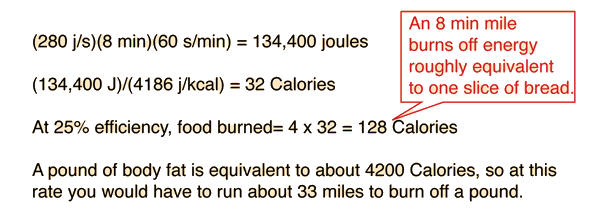The Dietary Calorie
The calorie is a unit used in the definition of specific heat, the specific heat of water being assigned the value 1 calorie/gram °C. That is, a calorie is the amount of heat necessary to raise the temperature of one gram of water by 1 degree Celsius. The unit which is commonly used for the measurement of the energy content of foods is the kilocalorie, but it is commonly called a Calorie with an upper case "C" to distinguish it from the smaller physical calorie. It is also referred to as a "dietary Calorie".
dietary Calorie = 1 kilocalorie = 1000 calories
A common example to give perspective on food energy is the amount of energy in a single peanut. That energy is commonly quoted as 5 Calories. If so, it can heat a liter of water 5 degrees Celsius, an impressive amount of energy. Another example is that of the energy to run a mile; it is perhaps dismaying to hear that to burn off the energy of a candy bar, you might have to run two miles!
The energy required for the work done by the body is obtained by the process of metabolism, which is ultimately similar in outcome to the burning of the food. The Calorie content of foods is typically measured by burning them in a pure oxygen atmosphere inside a calorimeter so that the energy release can be measured in terms of the temperature change of the calorimeter. The metabolic process makes energy available to the muscles and other systems in the form of adenosine triphosphate (ATP). The ATP is manufactured in the mitochondria of the cells.
|
